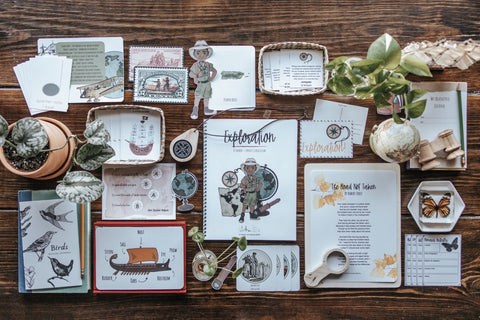
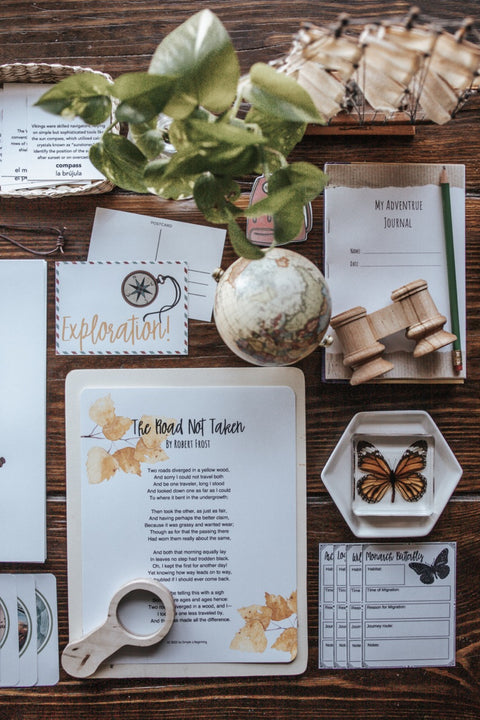
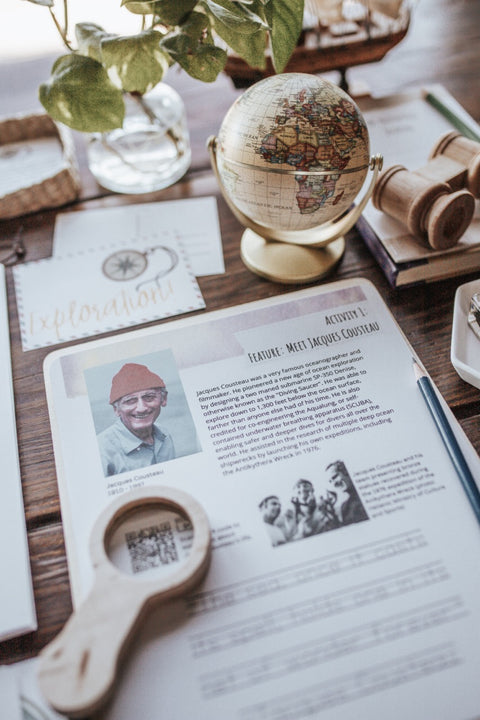
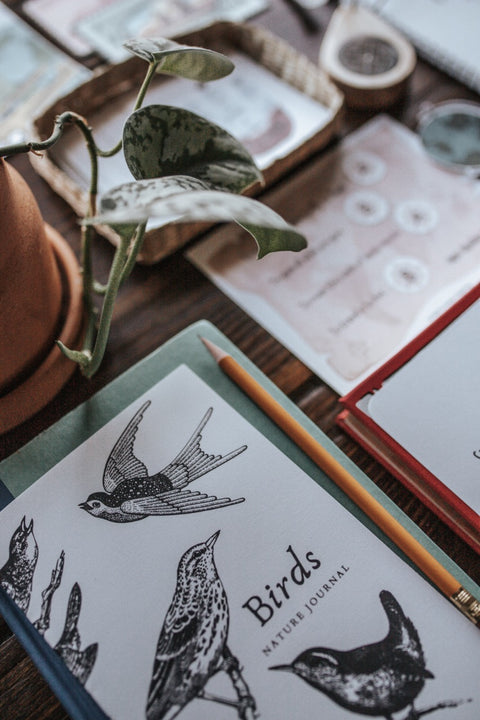
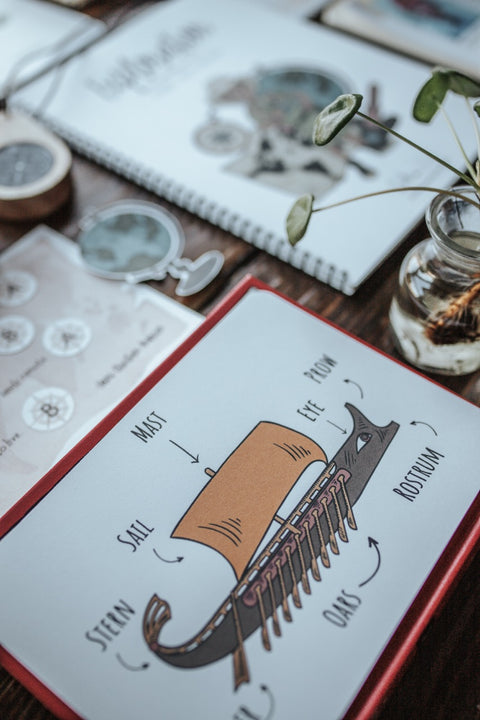
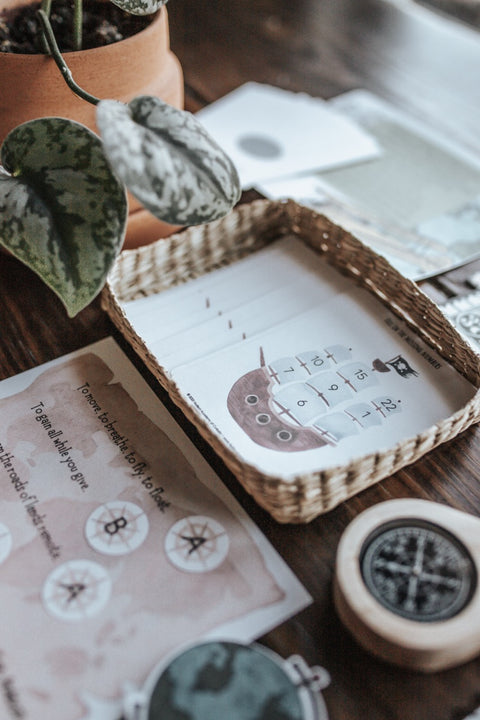
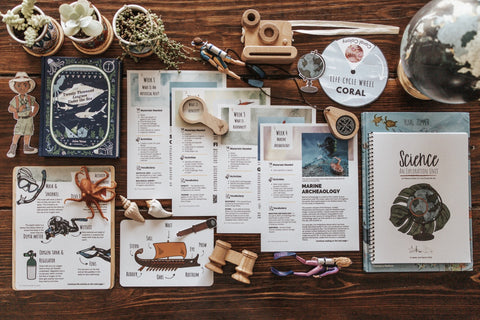
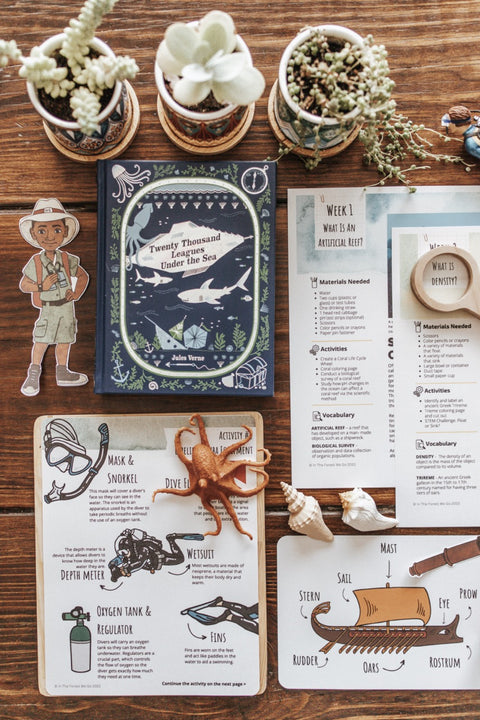
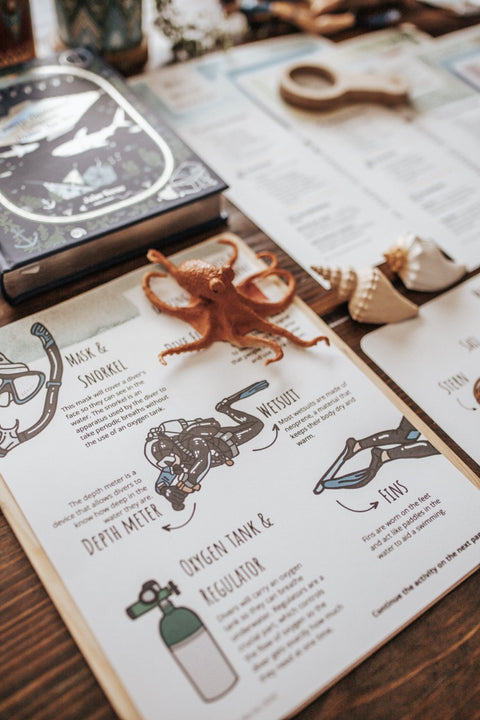
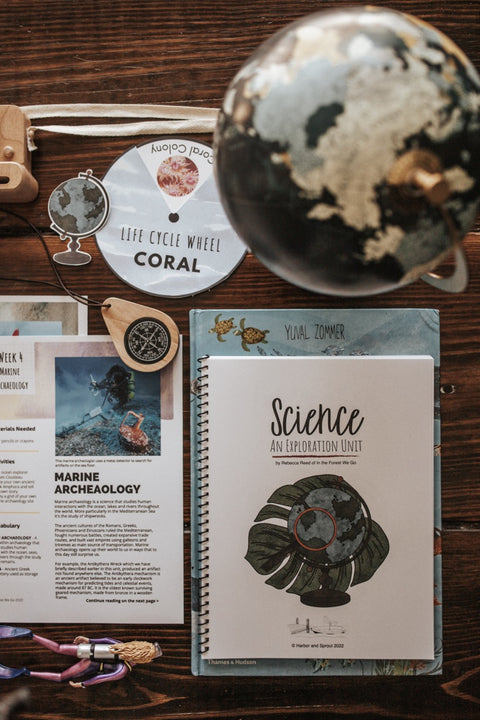
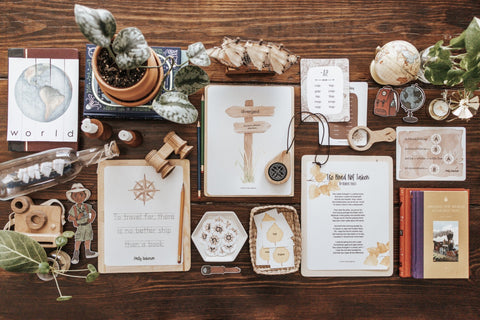
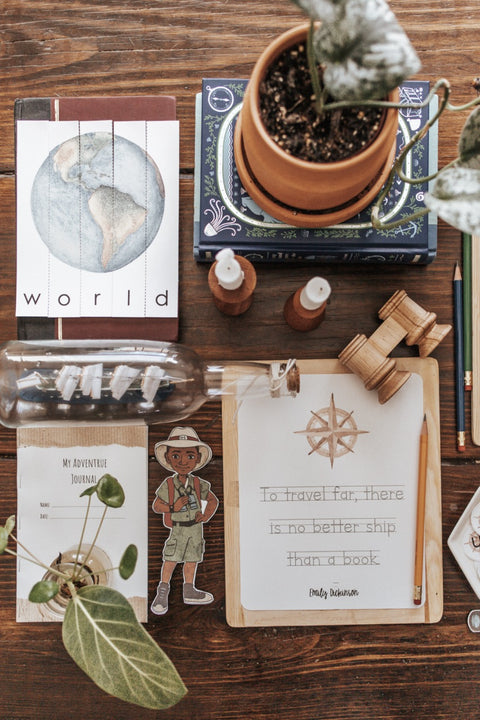
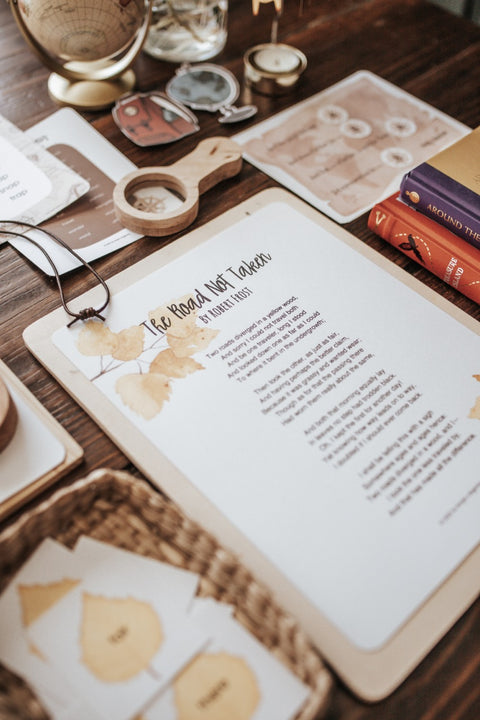
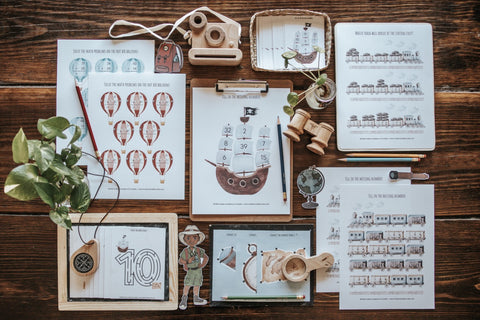
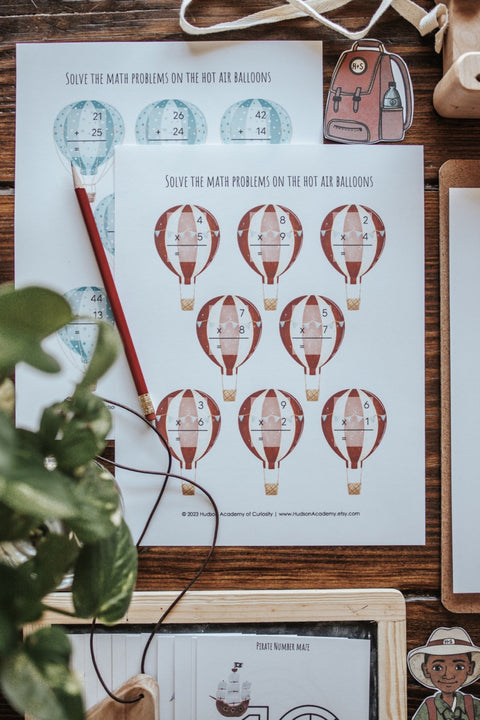
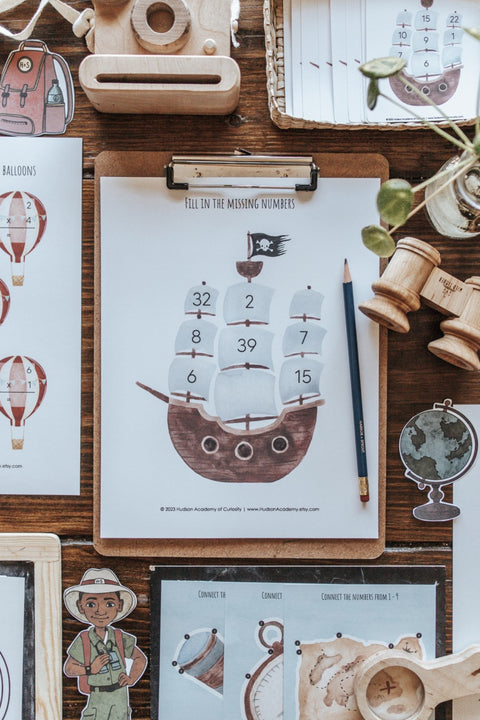
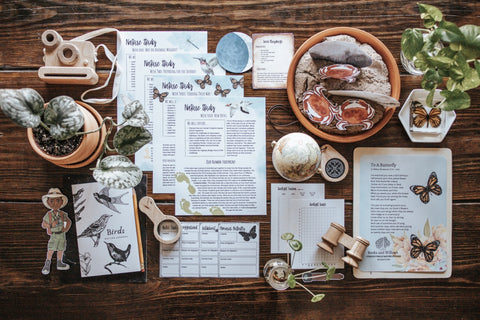
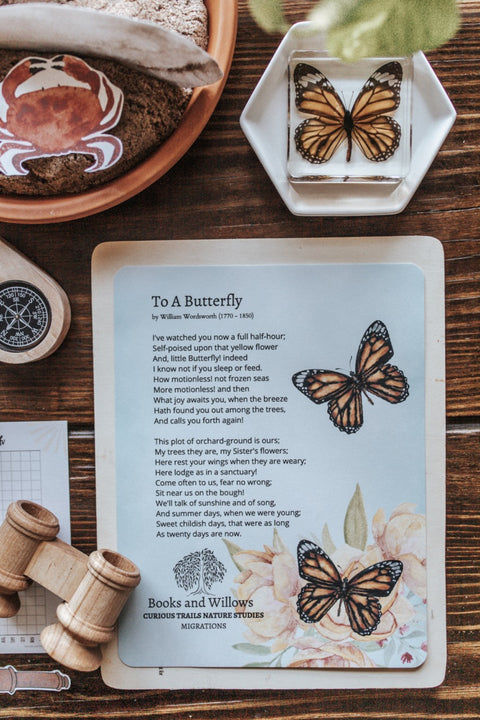
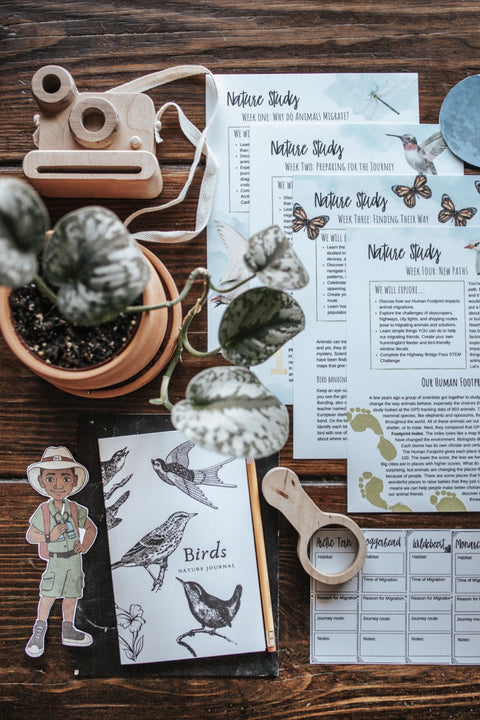
Harbor and Sprout
Exploration Patchwork Study
$30.00
$30.00
Calling all explorers! Get ready to set sail with pirates, travel to new destinations, and discover the far reaches of the earth with the Harbor + Sprout Exploration Patchwork Study, the January 2023 release of our original elementary-level homeschool unit study curriculum. This unit study features 4 weeks of lesson plans and materials covering all 9 of our core subjects plus a playful supplemental section of thematic activities. This unit study is meant for use by children ages 3-12.
This unit is delivered via a secure link as a digital download. Shop our corresponding Morning Basket Pack by Rebecca Clarke of Whimsy Printables here!
CONTENT:
Handbook
- Daily, weekly, and monthly planning pages
- Booklist including stories, poems, and field guides with recommended ages, subject correspondence, and brief summaries for each title
- Lesson plans for 4 levels of learning
- Family read-aloud recommendations
- Character kit- new monthly character illustrated by Stephanie Groves to act as your guide through the unit
- Unit Recipe
- Supply List
Science
- Week 1: What is an artificial reef?: Discover what a coral reef is. Learn about the Florida keys. Find out why coral reefs are important. Study how they can be damaged and also repaired by humans. Complete the color and trace activity. Fill out the biological survey. Create a coral life cycle wheel. Perform an experiment testing pH in water.
- Week 2: What is density?: Learn about Archimedes' principle of density and displacement. Find out how this applies to boat building. Learn about the Green trireme ship. Color and trace your own trireme ship. Complete the worksheet. Discover more about what floats and what doesn't with the "Sink or Float?" activity.
- Week 3: What is buoyancy?: Discover what makes things float. Study the history of scuba diving and diving equipment. Learn how divers make themselves rise and lower in the water. Complete the scuba diver color and trace activity. Label the scuba equipment. Conduct the Cartesian diver experiment.
- Week 4: Marine Archeology: Learn about exploring shipwrecks. Discover the science of marine archeology. Explore how marine archeologists study shipwrecks and what they can learn from them. Study the archeologist Jaques Cousteau. Learn about his discoveries and inventions. Design your own amphoras. Complete the marine archeological site activity.
Nature Study
- Week 1: Why do animals migrate?: Learn about animal migration. Learn what makes migration different than other animal movements. Discuss the three main reasons why animals migrate. Explore a few of the greatest migration journeys including those of wildebeests, dragonflies, and red crabs. Compare and map the journeys of the Arctic tern, monarch butterfly, porcupine, caribou herd, and more!
- Week 2: Preparing for the journey: Discover the internal and external cues that signal an animal it's time to migrate. Learn the different ways birds prepare for migration including hyperphagia, transforming organs, exercise, and molting. Track and graph changes in sunlight over the next few months. Follow our tips for birdwatching and keep an eye out for migration behaviors in your new Birds Nature Journal.
- Week 3: Finding their way: Learn the different ways migration is studied including banding, tracking devices, and stable isotope analysis. Discover the strategies animals use to navigate including magnetic fields, star patterns, and more! Make a DIY compass. Celebrate the amazing journeys of spawning salmon. Sculpt one from clay. Create your own mental map of a familiar route. Learn how to track Right Whale populations!
- Week 4: New paths: Discuss how our human footprint impacts animal migrations. Explore the challenges skyscrapers, highways, city lights, and shipping routes pose to migrating animals and solutions. Learn simple things YOU can do to help our migrating friends. Create your own hummingbird feeder and bird-friendly window decals. Complete the Highway Bridge Pass STEM Challenge.
Language Arts
- Week 1: Exploring Words: Learn about the -ap word family. Study exploring vocabulary. Choose a word to focus on and describe. Choose exploring words to learn to spell. Solve the spelling puzzles. Use the compass rose to help you practice spelling vocabulary words. Try to see how many words you can make using the letters from some adventure words. Research the origin of your favorite exploring word. Complete the copy work.
- Week 2: The Road Not Taken: Read or listen to the poem "The Road Not Taken." Enjoy a poetry picnic adventure as you listen to the poem. Match the word signs to their definitions. Group together the leaves into groups that rhyme. Summarize the poem using art, words, or both. Answer the poetry study questions. Complete the copy work.
- Week 3: Rhyme Scheme: Discover the concept of rhyme scheme. Learn how to find the rhyme scheme in a poem and how to label it. Match the rhyming words. Use the compass rose letters to label the rhyme scheme in each poem. Look up the lyrics of your favorite song and label the rhyme scheme.
- Week 4: Field Linguistics: Learn about the work of a field linguist and the Swadesh list. Watch the video in the QR code to expand your knowledge of field linguistics. Make a list of ten words that you think would be universal. Play universal charades. Listen to some words that you don't recognize and try to write them down correctly.
Writing
- Week 1: Adventure Journal: Begin your adventure journal project for the month. Choose a famous explorer to research. Read about your famous explorer. Fill out your adventure research worksheet. Print off your adventure journal pages and fill in your "All About Me" pages. Add illustrations and images. Answer the journal prompt.
- Week 2: Adventure Poem: Review different types of poetry. Practice writing adventure poems. You can write a Haiku, an acrostic poem, or a free verse poem. Edit one (or more) or your poems and add it to your adventure journal. Add illustrations and images if you would like. Answer the journal prompt for this week.
- Week 3: Adventure Letter: Pretend you are your famous explorer. Review how to format a letter. Then, write a letter home telling about your adventures. Write a rough draft on the worksheet provided. Then, add a final draft of your letter to your adventure journal. You can include illustrations and images if you would like! Finally, answer the journal prompt for the week.
- Week 4: Adventure Story: Learn about the parts of a story. Practice identifying the parts of a story while listening to a historical fiction read aloud. Fill out the "Parts of a Story" worksheet. Then brainstorm the parts of a story about your famous explorer. Write a rough draft of your story. Add your final draft to your adventure journal. Add illustrations and images if you would like. Then, answer the journal prompt for the week.
History
- Week 1: Leif Erikson: Consider what you already know about explorers by filling out the explorer character map. Learn about the history of exploration. Study Leif Erikson. Fill out the Leif Erikson character map. Design a postage stamp and complete the timeline.
- Week 2: Ferdinand Magellan: Study Ferdinand Magellan. Was he really the first man to circumnavigate the world? Fill out the Ferdinand Magellan character map. Design a postage stamp and complete the timeline. Send a postcard.
- Week 3: Ibn Battuta: Ltudy the adventures of Ibn Battuta. Discover all the countries he visited. Fill out the Ibn Battuta character map. Design a postage stamp and complete the timeline. Send a postcard.
- Week 4: Lewis and Clark Expedition: Learn about the Lewis and Clark expedition. Find out where they explored and what they hoped to find. Fill out the Lewis and Clark character map. Design a postage stamp and complete the timeline. Send a postcard about Lewis and Clark.
Geography
- Week 1: Puerto Rico: Discover some interesting facts about Puerto Rico including its national anthem, tree, flower, and capital city. Learn about the topography of Puerto Rico. Color the Puerto Rican flag. Test your knowledge of Puerto Rico facts with the included trivia cards.
- Week 2: Maps: Trace the continent of North America and island of Puerto Rico. Locate North America and the Puerto Rico on the map. Can you also find all seven continents? Cut out the labels and use them to label the map of Puerto Rico Label the blank map of Puerto Rico.
- Week 3: Indigenous Peoples of Puerto Rico: Discover the culture, language, cuisine, and housing of the Taino people. Learn about the petroglyphs they used. Create your own petroglyph stone. Design your own petroglyph symbol.
- Week 4: Map Making: Study the art of map making. Learn about different types of maps and what they are used for. Complete the "Which Map is Right?" activity page. Create your own 3D topographic map!
- Week 1: Exploring Beat and Tempo: Find out the difference between the beat and tempo of a song. Discover how different beats and tempos make us feel certain emotions. Listen to the songs in the QR codes and see if you can find the beat and tempo of each song. Draw a picture to represent a fast beat adventure and a slow beat adventure.
- Week 2: Mapping Out a Rhythm: Discover what makes up rhythm. Learn how many beats each note represents and how these notes work together to make a rhythm. Trace the music notes. Create your own rhythm! Solve the musical code to unlock the treasure chest. Complete the worksheet to identify which measures have a rhythm that adds up to 4 beats and which measures don't.
- Week 3: Let's Take a Rest: Find out how to show when not to make sound during a piece of music. Discover how many beats each type of rest represents. Trace the rests. Add rests to your "Build-a-Measure" activity from week two. Count the number of beats in each measure to solve the code and get the hermit crab to his new shell. Complete the worksheet to identify which measures have a rhythm that adds up to 4 beats and which measures do not.
- Week 4: The Guiro: Discover the Puerto Rican instrument called the guiro. Explore what it is made of and how it is played. Make your own guiro. Color the Caribbean instruments coloring page. Complete the "Add it up" review page.
Art
- Week 1: Polar Explorers: Study artist Anna Boberg and her art depicting frozen regions of the world. Learn about polar explorers and design your own flag. Make your own Aurora Borealis. Learn about icebergs and create iceberg art. Learn about the Challenger Expedition. Try your hand at monoprinting with a cute penguin monoprint project. Make a scene of polar bears in the snow. Enjoy coloring pages.
- Week 2: Pirates: Learn about Howard Pyle and his art. Learn about pirate flags and create a pirate flag of your own. Make a paper-cutting ship in a bottle. Learn about the famous pirate Blackbeard and draw yourself as a pirate captain. Create a pirate treasure map of your own! Create a sunken treasure chest with gemstones.
- Week 3: Vikings: Learn about artist Arturas Slapsys and enjoy his artwork. Create a partially 3-dimensional pirate ship collage. Learn about different styles of Viking art. Make a clay viking and practice clay techniques. Discover Elder Fulthark Runes and make your name in runes. Try your hand at embossing and make a viking coin bag project. Draw yourself as a viking.
- Week 4: Artists: Explore work by artist Sam Gilliam. Learn how to help your child experience art through the process of creation, then play with your art! Make a water drop painting, make fizzy paint, paint with ice cubes, paint with nature, and make a gravity painting. Complete an art challenge. Above all, enjoy the process!
Math
- Week 1: Multiplication and Comparing Quantities: Multiply the rocks in each train car. Find the total number for each train. Compare which train has the highest total product.
- Week 2: Number Sequence Train: Fill in the missing numbers to complete the number sequence on each train. Longer and shorter trains are provided for different learning levels.
- Week 3: Pirate Ship Mast Calculations: Calculate the total of the three numbers on the filled-in pirate mast. Use your addition and subtraction skills to fill in the the other two masts so that they add up to the same sum as the filled-in mast.
- Week 4: Pirate Number Connections and Mazes: Complete the pirate number connections (dot-to-dots). Have fun solving the pirate number mazes.
Nature Activities
- I Spy and Count
- Build a Word
- Coloring Pages
- Memory Disks
- Missing Letter Clip Cards
- Number Clip Cards
- Puzzles
- Silhouette Match
- Vikings 3 Part Cards (Spanish)
- Vikings Anatomy of a Ship (Spanish)
- Vikings Playdough Mats
- Vikings Explorer Puzzles
